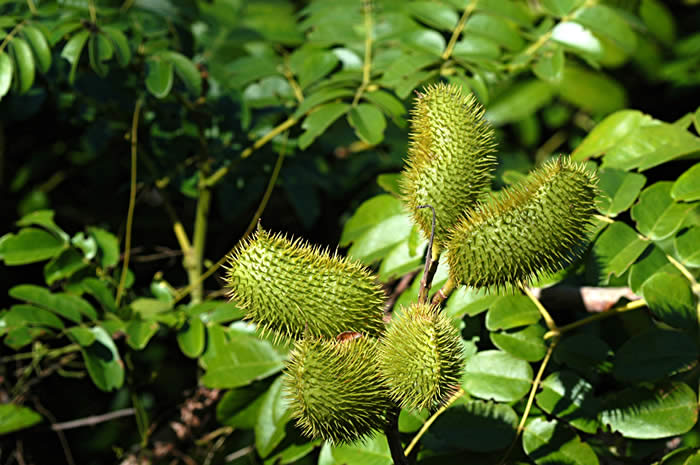Caesalpinia bonduc

|
|
Guilandina bonduc Common Names: Bonduc nut, Fever nut, Grey nicker,
Yellow nicker, Knicker nut, Molucca bean Scientific
Classification Kingdom: Plantae Clade: Tracheophytes Clade: Angiosperms Clade: Eudicots Clade: Rosids Order: Fabales Family: Fabaceae Subfamily: Caesalpinioideae Genus: Guilandina Species: G. bonduc Synonyms: Caesalpinia bonduc (L.) Roxb., Caesalpinia bonducella (L.) Fleming, Caesalpinia crista auct. Amer., Guilandina bonducella L. Morphological Description Guilandina bonduc is a robust, thorny, climbing or sprawling shrub, often
forming dense thickets up to 6–8 meters long. Its key characteristics include: · Stem: Green to greyish-brown, covered with recurved prickles
(0.3–0.5 cm long), woody at the base, and flexible enough to scramble over
vegetation (Srinivasan et al., 2024). · Leaves: Bipinnate, 30–45 cm long, with 6–9 pairs of pinnae; each
pinna bears 6–12 pairs of oblong-elliptic leaflets (1.5–4 cm × 1.2–2 cm),
glossy, with entire margins and scattered prickles on the rachis (Sasidharan et
al., 2021). · Flowers: Yellow, 1–1.5 cm in diameter, arranged in dense axillary or
supra-axillary racemes (10–15 cm long); each flower has 5 petals and 10 stamens,
emitting a faint sweet scent · Fruit and Seeds: Spiny pods (5–8 cm long), green turning
brown, containing 1–3 round, shiny, greyish-green seeds (1–2 cm diameter),
known as "nicker seeds," encased in a hard husk Distribution and Habitat Guilandina bonduc has a pantropical distribution, thriving in coastal and
inland environments: · Geographic Range: Native to tropical and subtropical
regions, including Africa (e.g., Nigeria, Ghana), Asia (India, Thailand,
Indonesia), Australia, the Pacific Islands, and the Americas (Caribbean,
Florida); widely naturalized due to seed dispersal by ocean currents · Habitat: Prefers sandy or loamy soils in coastal dunes, scrublands,
and upper shores; also found inland in lowland secondary forests and disturbed
areas near villages, tolerating annual rainfall of 1,000–2,500 mm and
elevations up to 500 m · Ecological Role: Stabilizes dunes and prevents erosion; its
buoyant seeds, known as "sea pearls," disperse via water,
contributing to its widespread distribution. Root nodules host nitrogen-fixing
bacteria, enriching soil for nearby plants Ethnopharmacology Guilandina bonduc (also known as Caesalpinia bonduc, fever nut, or nickernut) is a
medicinal plant highly valued in traditional medicine across Africa, Asia, and
the Caribbean. The seeds, leaves, bark, and roots are used for their
antimalarial, antidiabetic, anti-inflammatory, antimicrobial, analgesic,
antioxidant, and immunomodulatory properties. Traditionally, the seeds are used
to treat malaria, fevers, digestive disorders, and liver problems, while the
leaves and bark are employed in managing rheumatism, skin infections, ulcers,
and painful swellings. Decoctions made from the plant parts are also used to
boost male fertility and as a general tonic. Phytochemical studies have
identified bioactive compounds such as flavonoids, saponins, alkaloids,
terpenoids, and coumarins, which contribute to its medicinal actions. Although
Guilandina bonduc is prominent in traditional healing, more scientific studies
are required to confirm its therapeutic potential and ensure its safe usage. · Anti-inflammatory
and Analgesic Activities:
Guilandina bonduc exhibits significant anti-inflammatory effects, attributed to
the presence of flavonoids and other phytochemicals that inhibit inflammatory
mediators (Wikipedia, n.d.). · Antidiabetic
Effects: Studies have shown that
G. bonduc extracts can lower blood glucose levels in diabetic animal models,
suggesting potential antidiabetic properties (Srinivasan et al., 2024). · Anticancer
Activity: Compounds isolated from
G. bonduc, such as cassane diterpenoids, have exhibited cytotoxic effects
against cancer cell lines, indicating potential anticancer properties
(Sasidharan et al., 2021). · Antimalarial
Activity: G. bonduc has
demonstrated antimalarial properties in various studies, supporting its
traditional use in treating malaria (Sasidharan et al., 2021). ⚠ Toxicity Profile: The plant’s abortifacient properties, noted in
African ethnobotany, contraindicate its use during pregnancy. Seeds are toxic
if ingested raw due to cyanogenic glycosides; roasting reduces toxicity (Ayesha &
Saeed, 2021). Additional Uses · Ornamental and Cultural: The shiny, greyish-green seeds are crafted
into beads, necklaces, and ritual objects in Malaysia and the Caribbean; used
as counters in board games like Oware in Ghana. · Environmental: Planted for dune stabilization and erosion control in
coastal areas; its nitrogen-fixing roots enhance soil fertility. · Invasiveness: Can become invasive in non-native regions like parts of
Florida and Pacific Islands, outcompeting native flora due to prolific seed
dispersal. · Traditional Veterinary Use: In Nigeria, leaf decoctions treat
parasitic infections in livestock, supported by anthelmintic properties. References
External Links More Pictures |
|
| Compounds of Caesalpinia bonduc | |
| References |